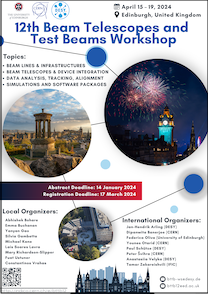Conveners
Test beam analysis: I
- Heiko Augustin (Heidelberg University (DE))
Test beam analysis: II
- Tobias Bisanz (Technische Universitaet Dortmund (DE))
The Endcap Timing ReadOut Chip (ETROC) for the CMS MIP Timing Detector is designed to process signals from Low-Gain Avalanche Diodes (LGAD) with a time resolution of 40-50ps per hit. The ETROC2 is the first full size (16x16) prototype design and full functionality design, and in this talk we present the results from the CMS ETROC suitcase style beam telescope results at CERN and DESY to study...
The High Luminosity upgrade of the CERN Large Hadron Collider (HL-LHC) calls for new high-radiation tolerant silicon pixel sensors, capable of withstanding, in the innermost tracker layer, fluences up to 2.3E16 neq/cm2 (1MeV equivalent neutrons). An extensive R&D program aiming at 3D pixel sensors, built with a top-side only process, has been put in place in CMS in collaboration with FBK...
The LHC is to enter a High Luminosity era in 2029, and many systems are to be upgraded or replaced in order to overcome challenges brought up by the vastly increasing luminosity. The corresponding Phase-2 upgrade of the CMS experiment is scheduled for Long Shutdown 3 in 2026. This includes installation of the entirely new Outer Tracker, consisting of two types of double-sensor modules, namely,...
The Alpha Magnetic Spectrometer (AMS-02) detector operates on the International Space Station. It performs high precision measurements of cosmic ray composition and fluxes, searches for antimatter and dark matter. To increase the detection acceptance and improve its heavy ion identification power, the AMS collaboration plan to add a new layer (L0) of silicon tracker on top of AMS-02. The...
Multiple Coulomb scattering of charged particles in matter is in high energy physics often seen as a nuisance due to its stochastic nature and the concomitant deterioration of tracking and momentum resolution. In this contribution studies on a technique are presented utilising this effect for the purpose of a medical imaging method, electronCT.
This technique applies radiation detectors...
The Circular Electron Positron Collide (CEPC) has been proposed to enable more thorough and precise measurements of the properties of Higgs, W and Z bosons, as well as to search for new physics. In response to the stringent performance presented by the vertex detector for the CEPC, a baseline vertex detector prototype was designed and tested using a 6 GeV electron beam at...
In high-energy physics, there is a need to investigate silicon sensor concepts that offer large-area coverage and cost-efficiency.
Sensors based on CMOS imaging technologies present an alternative silicon sensor concept for particle tracking detectors.
As this technology is a standardised industry process, it can provide a lower sensor production cost and access to fast and large-scale...
The ATLAS Inner Detector will be completely replaced with an all-silicon Inner Tracker (ITk) to withstand the harsh operational conditions of the High Luminosity LHC at CERN.
The ITk pixel detector will be located in the innermost part of the ITk. It will be instrumented with different sensor technologies according to the expected total fluence, which ranges up to $1.9 \cdot 10^{16}$...
The expected increase of the particle flux at the high luminosity phase of the LHC (HL-LHC) with instantaneous luminosities up to L ≃ 7.5×1034 cm−2 s-1 will have a severe impact on the ATLAS detector performance. The pile-up is expected to increase on average to 200 interactions per bunch crossing. The reconstruction and trigger performance for electrons, photons as well as jets and transverse...
CMOS foundries have recently introduced Single Photon Avalanches Diodes SPADs into process design kits, allowing for easy implementation of monolithic SiPMs with custom designed ASIC. In CMOS SPAD arrays, many features typical of monolithic pixel detectors can be implemented, enriching the capabilities of widely used analog SiPMs. In-pixel digitization, masking, full hitmap readout, and large...
